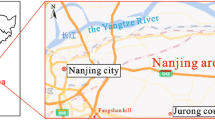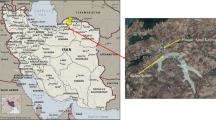Abstract
On March 5, 2020, a shallow loess landslide occurred in Yaoba Village, Songpan County, Sichuan Province, posing a severe threat to the lives and properties of 130 villagers. In this study, the landslide’s essential characteristics were identified through field investigations, and the failure mechanism of the landslide was analyzed through numerical simulations, laboratory experiments, and strength calculations. A new mechanism of the Yaoba loess landslide was proposed. The results show that (1) the minimum induced rainfall required for the landslide from the natural unsaturated state into the saturated state at the lowest thickness of 1.4 m was 177.2 mm. The limited amount of previous rainfall was not sufficient to make the landslide soil saturated and unstable. (2) Snowmelt water infiltration caused by abnormally high temperatures was the leading cause of the landslide failure. Based on the strong hydrodynamic conditions in the area and the confluence through the hollow region upstream of the landslide, abnormally high temperatures caused an increase in snowmelt values up to 219 mm. Snowmelt infiltrated into the slope and increased the water content up to a saturation state at 26.67%, making the shear strength of the soil reach the limit equilibrium state and be unstable. The analysis of the Yaoba landslide in western Sichuan that occurred during a dry spell will improve the early warning of groundwater- and snowmelt-induced shallow loess landslides.












Similar content being viewed by others
References
Chen J (2016) Risk assessment and prevention research of the loess landslide at songpan mounigou. Dissertation, Southwest Jiaotong University
Cui Y, Xu C, Xu S, Chai S, Fu G, Bao P (2020) Small-scale catastrophic landslides in loess areas of China: an example of the March 15, 2019 Zaoling landslide in Shanxi Province. Landslides 17:669–676
Dai F, Lee CF, Wang S (1999) Analysis of rainstorm-induced slide-debris flows on natural terrain of Lantau Island, Hong Kong. Eng Geol 51:279–290
Fan X, Xu Q, Scaringi G, Li S, Peng D (2017) A chemo-mechanical insight into the failure mechanism of frequently occurred landslides in the loess plateau, Gansu Province, China. Eng Geol 228:337–345 S001379521730889X
Fang Z, Wang Y, Ling P, Hong H (2020) Integration of convolutional neural network and conventional machine learning classifiers for landslide susceptibility mapping. Comput Geosci 139:104470
Gao HX, Yin KL (2007) Discussion on the correlations between landslides and rainfall and threshold for landslide early-warning and prediction. Rock Soil Mech 28:1055–1060
Guan Z, Zhu Y, Duan Y, Li Q, Wu Z (2002) Application of expanded Sacramento model in North China. Hydrology 2:36–39 (in Chinese)
Li T, Xi Y, Hou X (2018) Mechanism of surface water infiltration induced deep loess landslide. J Eng Geol 26(5):1113–1120
Nan J, Peng J, Zhu F, Ma P, Meng Z (2021) Shear behavior and microstructural variation in loess from the Yan’an area, China. Eng Geol 280:105964
Parker RN, Hales TC, Mudd SM, Grieve SWD, Constantine JA (2016) Colluvium supply in humid regions limits the frequency of storm-triggered landslides. Sci Rep 6:34408
Peng J, Wang S, Wang Q, Zhuang J, Huang W, Zhu X, Leng Y, Ma P (2018) Distribution and genetic types of loess landlisdes in China. J Asian Earth Sci 170:329–350
Pradel D, Raad G (1993) Effect of permeability on surficial stability of homogeneous slopes. J Geotech Eng 119:315–332
Seed RB, Cetin KO, Moss RES, Kammerer A, Wu J, Riemer MF (2001) Recent advances in soil liquefaction engineering and seismic site response evaluation. Fourth International Conference on Recent Advances in Geotechnical Earthquake Engineering and Soil Dynamics
Su B, Shen J (1988) Verification of the Sale mountian landslide with the variational method. Proceedings of the International Symposium on Engineering in Complex Rock Formations
Sugawara M, Kite GW (1995) The development of hydrological model - tank. J Exp Bot 63:5545–5558
Sun J (2002) Provenance of loess material and formation of loess deposits on the Chinese loess plateau. Earth Planet Sci Lett 203:845–859
Sun Y, Sun G, Guo X (2012) Analysis and evaluation of the landslide stability of Xiaoxing town, Songpan County, Sichuan Province. Water Res Hydropower Northeast 30:15–16 (in Chinese)
The standard of the People’s Republic of China (2008) Code for engineering geological investigation of water resources and hydropower: GB 50487–2018. Ministry of Housing and UrbanRural Development of the People’s Republic of China, Beijing
The standard of the People’s Republic of China (2016) Code for geological investigation of landslide prevention: GB/T 32864–2016. General Administration of Quality Supervision, Inspection and Quarantine of the People’s Republic of China, Beijing
The standard of the People’s Republic of China (2018) Standard for building construction in collapsible loess regions: GB 50025–2018. Ministry of Housing and UrbanRural Development of the People’s Republic of China, Beijing
Wang HB, Sassa K (2010) Rainfall-induced landslide hazard assessment using artificial neural networks. Earth Surf Process Landf 3:235–247
Xu Q, Zhao K, Liu FA, Peng D, Chen W (2020a) Effects of land use on groundwater recharge of a loess terrace under long-term irrigation. Sci Total Environ 751:142340
Xu Y, Allen MB, Zhang W, Li W, He H (2020b) Landslide characteristics in the loess plateau, northern China. Geomorphology 359:107150
Xu L, Yan D, Zhao T (2021) Probabilistic evaluation of loess landslide impact using multivariate model. Landslides 18:1011–1023
Yang L, Wei Y, Wang W, Zhu S (2019) Numerical runout modeling analysis of the loess landslide at Yining, Xinjiang, China. Water 11:1324
Zhang ZY, Chen SM, Tao LJ (2002) 1983 sale mountain landslide, Gansu province, China: reviews in engineering geology - catastrophic landslides: effects, occurrence, and mechanisms - the geological society of America. GSA Revi Eng Geol 15:149–163
Zhang AJ, Xing YC, Hu XL, Wang HT, Gao YP (2016) Influence factors of strong self-weight collapsibility of ili loess. Chin J Geotech Eng 38: doi: https://doi.org/10.11779/CJGE2016S2019
Zhang Y, Chen N, Liu M, Wang T, Deng M, Wu K, Khanal BR (2020) Debris flows originating from colluvium deposits in hollow regions during a heavy storm process in Taining, southeastern China. Landslides 17:335–347
Zhao BH, Zhang SP (2013) Research on the permeability of concrete under the high water pressure. Adv Mater Res 838–841:1797–1800
Zhao T, Sun B, Gibo S, Wang X, Zhou J (2000) Loess landslide in China and its mechanism. Sci Bull Coll Agric 47:113–121
Zhou Q, Xu Q, Peng D, Fan X, Ouyang C, Zhao K, Li H, Zhu X (2020) Quantitative spatial distribution model of site-specific loess landslides on the Heifangtai terrace, China. Landslides 18:1163–1176
Zhu Y, Dai F, Gao J, Yao X (2019) A recurrent composite loess landslide in southwestern China. Q J Eng Geol Hydrogeol 52:17–22
Funding
This study was financially supported by the National Natural Science Foundation of China (Grant Nos. U20A20110 and 41861134008), and the Youth Innovation Promotion Association CAS (Grant No. 2020367). All financial supports are greatly appreciated.
Author information
Authors and Affiliations
Corresponding authors
Rights and permissions
About this article
Cite this article
Wu, K., Chen, N., Hu, G. et al. Failure mechanism of the Yaoba loess landslide on March 5, 2020: the early-spring dry spell in Southwest China. Landslides 18, 3183–3195 (2021). https://doi.org/10.1007/s10346-021-01703-8
Received:
Accepted:
Published:
Issue Date:
DOI: https://doi.org/10.1007/s10346-021-01703-8




